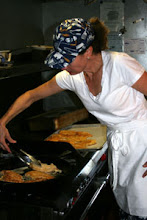
I want to love braised leeks, really I do. The French adore their les poireaux, which sound deliciously romantic in French, don't they? But then again, everything sounds sexy in French; especially if you say it slowly, as they do in the south of France.
Cervelles au beurre noir.
Calf's brains in brown butter. See?
The truth is, I'm in love with the idea of braised leeks, more than the actual leeks themselves.
Some of my favorite cookbooks include recipes for braised leeks: Julia Child's Mastering the Art of French Cooking, Alice Waters's Chez Panisse Vegetables, and Susan Spicer's Crescent City Cooking.
So why can't I fall over backwards for a dish of braised leeks? Or at least swoon a little at the thought.
Maybe I would change my mind if I just spent more time with them. So I did.
Here we go.
Simply braised leeks.

(Note: if you plan to serve the leeks as a side dish, count on 2 leeks per person.)
Cut off the root end and the dark green tops, keeping the light green portion. Cut in half and place under running water, fanning the layers to remove any grit trapped between the layers (or gnats, which I found a few in this batch --I love organic produce. You only need to worry when bugs don't want to eat your dinner) .
Place the leeks, cut side down, in a shallow sauce pan that's either buttered or swiped with olive oil. (You need some fat here. I wouldn't blink, or tattle, if you rubbed it with bacon fat.)
Pour in enough dry white wine to come up quarter of the way up the leeks. Using the smallest pan possible is key -- only if you want enough wine left over to drink.
Pour in enough chicken or vegetable stock to come up just over half way of the leeks. Sprinkle with fresh ground pepper.

Turn the heat to medium-high and bring the liquid to a boil. Reduce the heat to simmer, and cover with a lid, partially askew to allow some steam to escape.
Cook until the leeks are tender and the tip of a knife easily pierces through the leek, about 30-40 minutes, turning the leeks twice: once after 10 minutes and then again after another 10 minutes.

Now, for the best part -- a buttered, bread crumb topping.
Time to get that broiler heating. Place the leeks, in a single layer, in a shallow, oven-proof baking dish.
For each portion of leeks, mix two tablespoons of whole wheat bread crumbs (nutty flavor and ultimately crunchier texture) with one tablespoon of grated Parmigiano-Reggiano and toss with a tablespoon of melted butter.
Season with salt and pepper. You could also mix in some chopped fresh herbs if you have any.

Sprinkle the crumb topping over the leeks and place the leeks underneath the broiler until the crumb topping is dark brown and crispy, maybe a couple, three minutes, depending upon how close the heat source is to the leeks.
And there you have it. Tender, braised leeks, with a delicate, sweet, faintly onion flavor. Quite lovely.
After a late afternoon rendezvous, I get the allure: the tactile pleasure of cutting and cleaning leeks; the flittering, wispy aroma, happy to escape the sliver of a crack between the pan and lid. I can see myself making a whole roasting pan full. But still...

after all that, why do I still think of leeks as a seasoning and not a side dish?
Is something wrong with me because of my lack of overt passion for leeks?
Where did this indifference come from? Blame it on early American settlers who weren't in the least bit smitten with the leek.
Neither were early American cookbook authors, writing a couple hundred years after the Pilgrims landed, portraying leeks as a mere flavoring ingredient -- nothing special and certainly not worthy of serving alone.
When it comes to leeks, I rationalize I'm simply all-American.































